Caveat lectorem: When readers submit comments, they are asked if they want to receive an email alert with a link to new postings on this blog. A number of people have said they do. Thank you. The link is created the moment a posting goes online. Readers who find their way here through that link can see an updated version by simply clicking on the headline above the posting.
The saloon keeper who had owned the Old Western in Point Reyes Station since 1977, Judy Borello, died two days ago.
 The saloon is now on the market, but Ms. Borello continues to have a loud voice (or moo) in the town. Here’s the story as SparselySageAndTimely originally told it in 1986.
The saloon is now on the market, but Ms. Borello continues to have a loud voice (or moo) in the town. Here’s the story as SparselySageAndTimely originally told it in 1986.
Judy Borello at left.
This story really begins in the 1970s with the late historian Jack Mason of Inverness. Back then before the new county Public Safety building was built in Point Reyes Station, there was a lifeless town clock on the old firehouse. Mason, who then wrote Funny Old World for The Point Reyes Light, periodically used the column to decry the sad condition of the clock.
So when the new county building opened in 1984, directors of the Point Reyes Business Association agreed the structure should be adorned with a town clock that worked. A question then arose as to whether the clock should set off a noon whistle like those in Inverness, Bolinas, and Stinson Beach. Photographer Art Rogers jokingly suggested a moo would be even more appropriate for this cow town. A few months later, however, the association sent away for a town clock sans whistle or moo.
By the time the mechanism arrived, the business association had a new president, saloonkeeper Borello, and she agreed to resurrect the once-proposed moo. Ms. Borello told her plan to Nicasio artist George Sumner, and he offered to get help from filmmaker George Lucas.
Lucasfilm vice president Eric Westin is a friend of Sumner, and he lined up a Lucas technician, Rick Brown, to provide a moo recording, which Brown did. Ms. Borello then prevailed upon Gene Haley, a town electrician, to wire a loudspeaker system to the town clock.
Now the firehouse is a couple of blocks off the main street, sharing its neighborhood with a number of residences, and fireman Pete Valconesi suggested these neighbors might find the daily moo unsettling. President Borello said that was no problem; the loudspeaker could instead be mounted on top of her saloon.
The moo debut
She then set about informing news media throughout the Bay Area that the noon moo would soon debut. The response surprised even the saloonkeeper. Within a couple of days, newspapers far and wide began reporting that the noon moos were already underway. A paper in London reported the moos were every hour on the hour.
When it finally did come time for the mooing to commence at noon, five television crews and several newspapers were on hand to record the event.
Unfortunately, some problems had developed. The move from the firehouse to the roof of the Old Western Saloon meant the mooing could no longer be connected to the new town clock. Instead, the sound system was given a clock of its own, which Ms. Borello said was “synchronized” with the town clock.
The fact that the mooing would not be in the vicinity of the town clock was a particular problem for the TV cameramen, who were left with only a loudspeaker to film. Saloonkeeper Borello solved the problem by having artist Sumner display in the Old Western his painting for the official Statue of Liberty poster.
“Why are you doing all this?” a television reporter asked Ms. Borello. “The moo is the soul and flavor of our town,” the saloonkeeper replied. But the media wanted more, so Ms. Borello decided to use the occasion to take a stand in a current town debate over whether the Martinelli ranch should be subdivided or bought for parkland. “We’ve lost a lot of ranches to the park,” the saloonkeeper declared. “We don’t want to lose any more.”
‘Moo power’
The pronouncement set the reporters off in a new direction. Several news reports said the noon moo symbolized ranchers organizing to fight parks; they dubbed the supposed movement “moo power.” The next morning, I received a call from a cattle rancher in Contra Costa County who wanted West Marin’s ranchers to join in a fight against the East Bay Regional Park System. I gave her the phone numbers of the Farm Bureau and the Old Western Saloon.
The publicity continued to build on itself although soon it was no longer clear just what was being publicized. Ms. Borello’s anti-government remarks received particular interest in the Midwest, where the Reagan Administration was being blamed for thousands of farm foreclosures.
Radio stations calling from Ohio, New York, Alaska all wanted to record the moo, and for awhile, the saloon complied, setting off the sound system and holding a phone receiver out the door to catch the moos blaring from the roof. Eventually, Ms. Borello began worrying about her neighbors’ reaction to all the unscheduled mooing and had a recording made that could be played on a tape deck in the bar.
To be available to satisfy late-night moo requests, Ms. Borello took a copy of the recording home with her at night and played it for the press when it called. When an overseas journalist called to record it one evening, Ms. Borello set the phone down on the bed and went to get her tape deck. Her husband Bob meanwhile went back to sleep and was soon snoring next to the phone.
When Ms. Borello came back on the line, the journalist commented, “That was the worst mooing I’ve ever heard.”
And even now the mooing goes on. Yestereday Lynn and I were sitting across the street at Toby’s Coffee Bar when a moo began blaring. A startled group of tourists at another table looked up to see where the noise was coming from, amused but not alarmed. I’m glad we still have the noon moo to remind us of Ms. Borello.


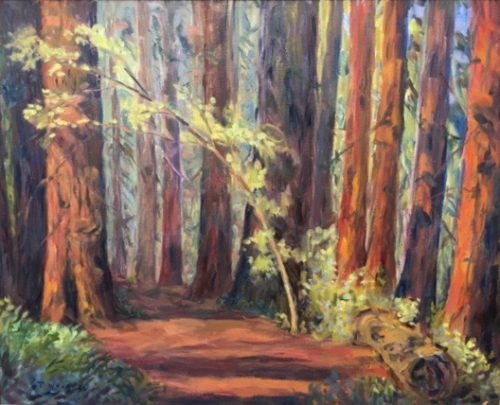
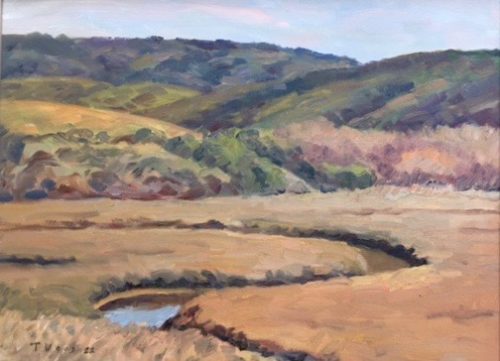
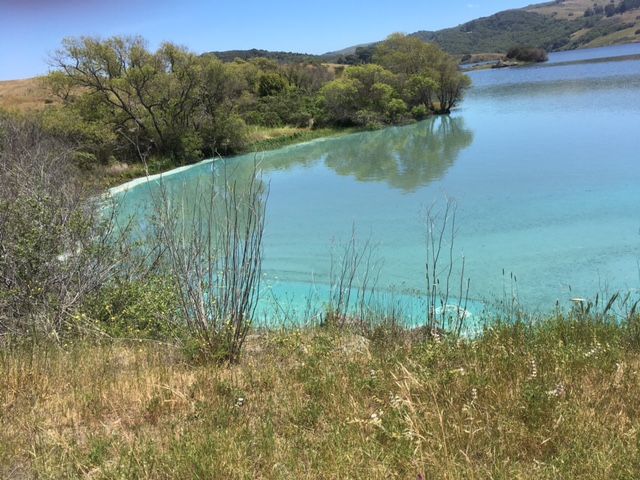 Nicasio Reservoir changing hues. On our way home from Wood’s exhibit, my wife Lynn Axelrod Mitchell, and I stopped beside Nicasio Reservoir to try to figure out what is making a cove look light blue. It couldn’t be art. Could it be chemistry? (Lynn, by the way, shot all the photos in this posting on her Iphone because the battery in my Nikon was dead.) The shoreline at left is lined with foam, so I called Marin Municipal Water District, which owns the reservoir, to find out if it knew of anything dangerous in the water.
Nicasio Reservoir changing hues. On our way home from Wood’s exhibit, my wife Lynn Axelrod Mitchell, and I stopped beside Nicasio Reservoir to try to figure out what is making a cove look light blue. It couldn’t be art. Could it be chemistry? (Lynn, by the way, shot all the photos in this posting on her Iphone because the battery in my Nikon was dead.) The shoreline at left is lined with foam, so I called Marin Municipal Water District, which owns the reservoir, to find out if it knew of anything dangerous in the water.
 • “Capitalism enables corporate masters to exacerbate crisis of health, poverty, oppression, climate change and war in allegiance to profit,” writes John Thompson Parker (left), Peace and Freedom Party candidate for the Senate. “Ownership of production and finance must be controlled by the people. This senate campaign is about building that socialist systematic change.”
• “Capitalism enables corporate masters to exacerbate crisis of health, poverty, oppression, climate change and war in allegiance to profit,” writes John Thompson Parker (left), Peace and Freedom Party candidate for the Senate. “Ownership of production and finance must be controlled by the people. This senate campaign is about building that socialist systematic change.”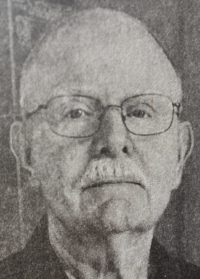

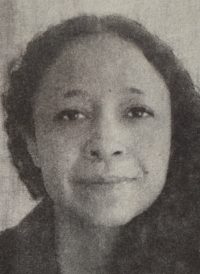
 The saloon is now on the market, but Ms. Borello continues to have a loud voice (or moo) in the town. Here’s the story as SparselySageAndTimely originally told it in 1986.
The saloon is now on the market, but Ms. Borello continues to have a loud voice (or moo) in the town. Here’s the story as SparselySageAndTimely originally told it in 1986.